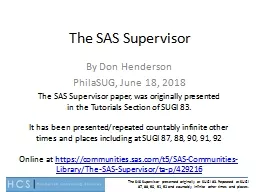PPT-The SAS Supervisor By Don Henderson
Author : pamela | Published Date : 2021-01-27
PhilaSUG June 18 2018 The SAS Supervisor paper was originally presented in the Tutorials Section of SUGI 83 It has been presentedrepeated countably infinite other
Presentation Embed Code
Download Presentation
Download Presentation The PPT/PDF document "The SAS Supervisor By Don Henderson" is the property of its rightful owner. Permission is granted to download and print the materials on this website for personal, non-commercial use only, and to display it on your personal computer provided you do not modify the materials and that you retain all copyright notices contained in the materials. By downloading content from our website, you accept the terms of this agreement.
The SAS Supervisor By Don Henderson: Transcript
Download Rules Of Document
"The SAS Supervisor By Don Henderson"The content belongs to its owner. You may download and print it for personal use, without modification, and keep all copyright notices. By downloading, you agree to these terms.
Related Documents














